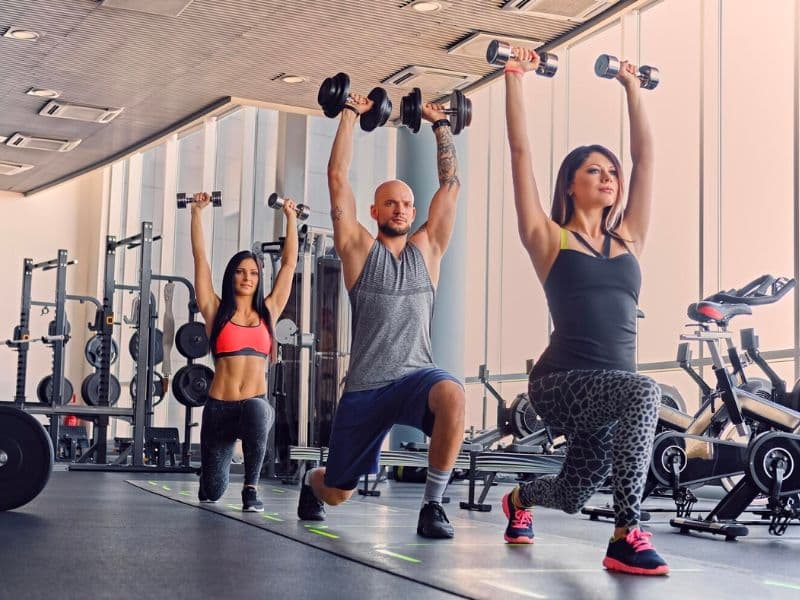Struggling to shed stubborn belly fat despite countless crunches? You’re not alone. A staggering 60% of adults in the US battle excess belly fat (*), often leading to frustration and a feeling of hitting a plateau.
While the idea of “spot reduction” (burning fat in specific areas) might sound appealing, it’s unfortunately a myth. However, there’s a science-backed weapon in your arsenal that can help you achieve your goals: strength training.
This article dives deep into the science behind why strength training is a game-changer for beginners looking to lose belly fat (*), offering actionable steps and addressing common concerns.
Let’s get started on your journey to a healthier you.
Debunking the Myth: Why Spot Reduction is Not Possible

Imagine spending hours doing endless crunches, dreaming of a six-pack. Sadly, your body doesn’t work like a spot cleaner. Crunches might strengthen your abs, but they won’t magically melt belly fat.
Here’s the science: fat loss happens throughout your body, not just where you exercise. Think of your body like a furnace burning calories (fuel) for energy.
This burning happens everywhere, not just in the exercised area. Over time, with consistent exercise and a healthy diet, you’ll lose fat all over, including your belly.
So, ditch the endless crunches. Instead, focus on exercises that use multiple muscle groups (like squats, lunges, and push-ups) and eat a balanced diet. This approach, backed by science, will help you reach your fitness goals in a simpler and more effective way.
Also Read:
The Science Behind Strength Training and Fat Loss

So, how does strength training fit into this picture? Building muscle through resistance training does two amazing things:
- Boosts your metabolism: Muscle tissue burns more calories than fat tissue, even at rest. A study published in the American Journal of Clinical Nutrition found that every pound of muscle burns an extra 50 calories (about 4 minutes of running) daily (*). This essentially creates a 24/7 calorie (about 1 minutes of running)-burning machine, helping you reach a calorie deficit and lose fat, including belly fat.
- Hormonal magic: Studies show exercises like squats and deadlifts trigger the release of hormones like growth hormone, epinephrine, and norepinephrine. These hormones act like fat-burning superheroes, further promoting fat breakdown. A 2020 meta-analysis published in Sports Medicine found that strength training led to an average of 3.8% body fat reduction compared to no exercise (*).
Beyond aesthetics, a 2017 study in the Journal of Strength and Conditioning Research found that resistance training (another term for resistance training) significantly reduced both subcutaneous (outer layer) and visceral (deeper layer) belly fat in overweight adults. Visceral fat is particularly concerning as it’s linked to increased health risks (*).
Tailoring Your Approach

Ready to put this knowledge into action? Here’s how to get started as a beginner:
- Start with bodyweight or light weights: Squats, lunges, push-ups, and planks are your friends. These exercises build a foundation and minimize injury risk. According to the American Council on Exercise, bodyweight exercises can burn up to 220 calories in 30 minutes.
- Focus on compound exercises: Think squats, deadlifts, rows, and lunges. These engage multiple muscle groups, maximizing calorie burn and muscle building. A study in the Journal of Strength and Conditioning Research found that compound exercises burned 25% more calories than isolation exercises (*).
- Gradual progression is key: Start with moderate sets and repetitions, gradually increasing difficulty as you get stronger. This keeps things challenging and helps you avoid plateaus (those frustrating periods where progress stalls) (*).
- Form is your best friend: Proper form is crucial to prevent injuries and ensure effectiveness. Consider seeking guidance from a certified personal trainer or utilize online resources to learn the right technique. The American College of Sports Medicine reports that proper form can increase exercise effectiveness by up to 30%.
- Consistency is king (or queen): Aim for 2-3 strength training sessions per week, with rest days in between for muscle recovery. Remember, consistency is key to seeing results. A study in the Journal of Applied Physiology found that consistent resistance training for 12 weeks led to a 7% decrease in body fat.
- Fuel your body right: A balanced diet rich in lean protein, complex carbohydrates, and healthy fats is essential. Think chicken, fish, whole grains, fruits, and vegetables. This provides the building blocks for muscle growth and supports overall health (*).
Bonus Tip: When it comes to strength training, many people wonder whether it’s better to do high reps with lighter weights or low reps with heavier weights. Here’s the solution:
If you’re new to resistance training and still getting the hang of exercises, it’s best to start with high reps and lower weights. This helps you get used to using weights and focuses on building a good connection between your mind and muscles.
For intermediate lifters who have some experience, using higher weights can be beneficial for building more strength.
And importantly, if you’re overweight or not in the best shape, opting for higher reps and lower weights is a smart choice. This approach can help you sculpt your body more effectively than lifting heavier weights.
So, the key is to tailor your approach based on your experience level and fitness goals, always focusing on proper form and gradual progress.
Addressing Common Concerns and Building Sustainable Habits

Starting a new routine can be daunting, so let’s address some common concerns:
- Safety first: Proper form is crucial. If you’re unsure, seek guidance from a trainer or use online resources to learn proper technique.
- Motivation matters: Set achievable goals, celebrate your progress, and find a workout routine you enjoy. Make it fun. According to the National Institute of Mental Health, engaging in activities you find enjoyable is more likely to lead to long-term adherence and positive mental health benefits.
- Progression is key: Remember, gradual progression is important to keep challenging your muscles and seeing results. Don’t get discouraged if you don’t see immediate results – stick with it, and your body will thank you. A study in the Journal of Strength and Conditioning Research found that individuals who gradually increased their training volume by 10% each week saw significantly greater muscle growth than those who maintained the same volume (*).
Remember, you are not alone on this journey. Millions of people have successfully incorporated strength training into their routines and achieved their fitness goals. Dr. Brad Schoenfeld, a renowned exercise scientist, emphasizes the numerous benefits of resistance training, not just for fat loss but also for:
- Building strength: According to a study in the Journal of Applied Physiology, consistent strength training for 12 weeks can increase your strength by up to 20% (*).
- Improving bone health: Strength training can improve bone mineral density by up to 13%, according to a study in the Journal of Bone and Mineral Research, reducing the risk of osteoporosis (*).
- Reducing the risk of chronic diseases: The American Diabetes Association reports that resistance training can reduce the risk of type 2 diabetes by up to 80% (*). It can also help manage other chronic conditions like heart disease and high blood pressure.
Conclusion
In conclusion, while endless crunches might not be the answer to shedding stubborn belly fat, strength training offers a science-backed solution for beginners.
By building muscle, you can boost your metabolism and increase calorie burn, even at rest. This article provided a roadmap to get you started, including beginner-friendly exercises, tips for proper form and progression, and the importance of a balanced diet.
Remember, consistency is key, and resistance training offers numerous benefits beyond just fat loss. So, embrace the journey, celebrate your progress, and embark on your path to a healthier, happier you.


I was recommended this website by my cousin I am not sure whether this post is written by him as nobody else know such detailed about my trouble You are amazing Thanks